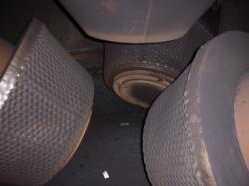
News Date:2017-01-06 14:25:09
vertical roller mills are the key equipment used for coal pulverisation. The essential requirements of pulverisation are grinding, heating, classification and transport of the pulverised coal from the pulveriser.
The grinding elements coupled with proper alignment and compression are critical to coal pulverisation in the lower mill body (grinding zone) while the classification of the pulverised coal, discharge and recirculation, it is critical in the upper vertical mill body.
 The proper metering, distribution and control of air flow through the mill, called primary air, is critical throughout the pulveriser and is the bridge between the lower grinding zone and the upper classification zone.
The proper metering, distribution and control of air flow through the mill, called primary air, is critical throughout the pulveriser and is the bridge between the lower grinding zone and the upper classification zone.
The coal pulveriser is the critical component of the fuel delivery system and is a major influence of combustion efficiency in the burner zone as well as the performance and efficiency of the furnace itself. As such the coal pulveriser is truly the 'heart' of the combustion process for a coal-fired power station.
Coal pulveriser design
In general, coal pulverisers are designed to achieve the maximum rated capacity grinding a design coal with a grindability of 55 HGI and 8-12 per cent moisture and achieving a discharge fineness of 70 per cent passing a 200 mesh screen (74 micron) and 99.5 per cent passing a 50 mesh screen. Variation of the coal hardness and/or moisture content will effect, up or down, the discharge capacity or the discharge fineness.
In order to achieve these design considerations, it is essential that the grinding elements are in good condition and maintain a consistent profile. The loss of the grinding profile results in a loss of grinding efficiency, meaning the pulveriser must work harder to achieve an equal result.
Wear mechanisms in a coal pulveriser
Compression, abrasion and impact are the three wear mechanisms that act upon the grinding elements and the pulveriser internals.
Compression is a wear component that results from the crushing of the material upon itself (attrition) between the grinding elements, it between the tyres/rolls and the table. Compression is a force that acts normal (perpendicular) to the surface of the grinding elements.
Abrasion is a velocity driven wear component that results when the crushed material that is suctioned off the bowl and entrained in the primary air rushes past the grinding elements. Abrasion is a shearing force that acts upon the grinding elements at an acute angle. The severity of abrasion is a function of the shear angle, the primary air velocity and the abrasiveness of the entrained material.
Impact is a momentum driven wear component that is a function of the density and the force by which the component being crushed or impacted makes contact with the crushing surface.
The primary source of impact wear in coal vertical roller mill is generally from undesirable dense rock or tramp metal that enters the pulveriser with the coal.
Compression and abrasion are the primary wear mechanisms that affect the grinding elements in a coal pulveriser.
Several factors will influence the type and the severity of wear. The largest influences will be the quality of the coal being processed, the required capacity factor on the pulveriser, the PA mass flow rate, distribution, and resulting velocity profile around the bowl and pulveriser body and the orientation of the grinding elements relative to the velocity vectors.
Quartz (SiO2), found in ash, is the most abrasive component of coal and has a hardness of 1700-1800 Vickers. Quartz, being dense, will tend to concentrate itself on the table/bowl. The build-up of quartz on the bowl will increase the wear due to compression and the quartz that becomes entrained in the air stream will aggressively attack by abrasion the exposed grinding elements as well as the other exposed mill internals. A small increase in PA velocity can yield a large increase in abrasive wear when significant amounts of quartz are present.
Pulveriser grinding elements
Pulveriser grinding elements that are composed of materials that can withstand these mechanisms of wear will aid by minimising the wear velocity on the tyres and the table thus maintaining a more consistent grinding profile for a longer period thereby achieving optimised grinding efficiency for a much longer duration.
Xwin castings, a composite matrix of granularised ceramic and a high chrome alloy, is such a material. Xwin castings provide the ductility expected of high chrome alloys combined with the hardness of ceramic. Xwin has a composite hardness of 2100 Vickers compared with 700-850 Vickers for high chrome alloys and high chrome hardfacing.
Xwin provides a longer lasting, wear resistant grinding element ,more consistent, which is crucial to pulverizer operation, yielding longer operating campaigns, reduced maintenance, improved or maintained grinding efficiency, lower overall invested cost. Xwin is the next frontier in material advancement for severe duty applications such as coal crushe.